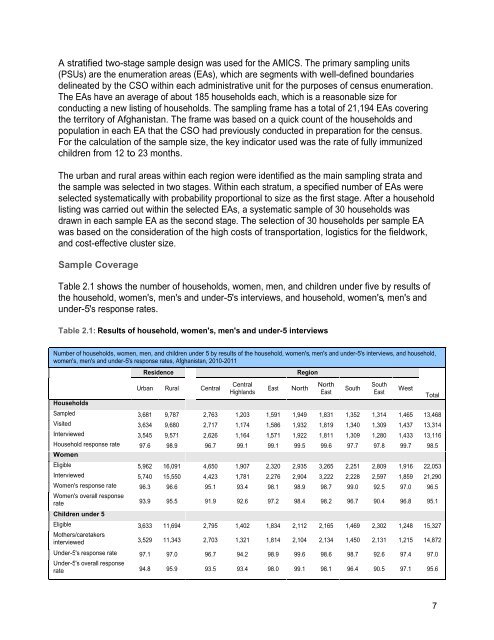Microsoft Word - AMICS-29Jan2013 - Childinfo.org
Microsoft Word - AMICS-29Jan2013 - Childinfo.org
Microsoft Word - AMICS-29Jan2013 - Childinfo.org
Create successful ePaper yourself
Turn your PDF publications into a flip-book with our unique Google optimized e-Paper software.
A stratified two-stage sample design was used for the <strong>AMICS</strong>. The primary sampling units<br />
(PSUs) are the enumeration areas (EAs), which are segments with well-defined boundaries<br />
delineated by the CSO within each administrative unit for the purposes of census enumeration.<br />
The EAs have an average of about 185 households each, which is a reasonable size for<br />
conducting a new listing of households. The sampling frame has a total of 21,194 EAs covering<br />
the territory of Afghanistan. The frame was based on a quick count of the households and<br />
population in each EA that the CSO had previously conducted in preparation for the census.<br />
For the calculation of the sample size, the key indicator used was the rate of fully immunized<br />
children from 12 to 23 months.<br />
The urban and rural areas within each region were identified as the main sampling strata and<br />
the sample was selected in two stages. Within each stratum, a specified number of EAs were<br />
selected systematically with probability proportional to size as the first stage. After a household<br />
listing was carried out within the selected EAs, a systematic sample of 30 households was<br />
drawn in each sample EA as the second stage. The selection of 30 households per sample EA<br />
was based on the consideration of the high costs of transportation, logistics for the fieldwork,<br />
and cost-effective cluster size.<br />
Sample Coverage<br />
Table 2.1 shows the number of households, women, men, and children under five by results of<br />
the household, women's, men's and under-5's interviews, and household, women's, men's and<br />
under-5's response rates.<br />
Table 2.1: Results of household, women's, men's and under-5 interviews<br />
Number of households, women, men, and children under 5 by results of the household, women's, men's and under-5's interviews, and household,<br />
women's, men's and under-5's response rates, Afghanistan, 2010-2011<br />
Households<br />
Residence<br />
Urban Rural Central<br />
Central<br />
Highlands<br />
East<br />
Region<br />
Sampled 3,681 9,787 2,763 1,203 1,591 1,949 1,831 1,352 1,314 1,465 13,468<br />
Visited 3,634 9,680 2,717 1,174 1,586 1,932 1,819 1,340 1,309 1,437 13,314<br />
Interviewed 3,545 9,571 2,626 1,164 1,571 1,922 1,811 1,309 1,280 1,433 13,116<br />
Household response rate 97.6 98.9 96.7 99.1 99.1 99.5 99.6 97.7 97.8 99.7 98.5<br />
Women<br />
Eligible 5,962 16,091 4,650 1,907 2,320 2,935 3,265 2,251 2,809 1,916 22,053<br />
Interviewed 5,740 15,550 4,423 1,781 2,276 2,904 3,222 2,228 2,597 1,859 21,290<br />
Women's response rate 96.3 96.6 95.1 93.4 98.1 98.9 98.7 99.0 92.5 97.0 96.5<br />
Women's overall response<br />
rate 93.9 95.5 91.9 92.6 97.2 98.4 98.2 96.7 90.4 96.8 95.1<br />
Children under 5<br />
Eligible 3,633 11,694 2,795 1,402 1,834 2,112 2,165 1,469 2,302 1,248 15,327<br />
Mothers/caretakers<br />
interviewed 3,529 11,343 2,703 1,321 1,814 2,104 2,134 1,450 2,131 1,215 14,872<br />
Under-5's response rate 97.1 97.0 96.7 94.2 98.9 99.6 98.6 98.7 92.6 97.4 97.0<br />
Under-5's overall response<br />
rate 94.8 95.9 93.5 93.4 98.0 99.1 98.1 96.4 90.5 97.1 95.6<br />
North<br />
North<br />
East<br />
South<br />
South<br />
East<br />
West<br />
Total<br />
7

















